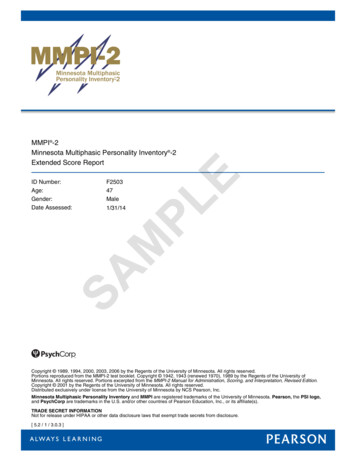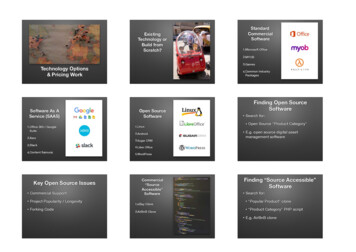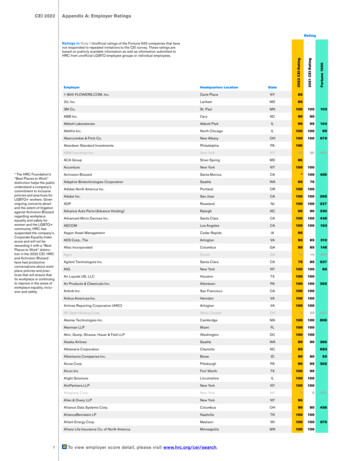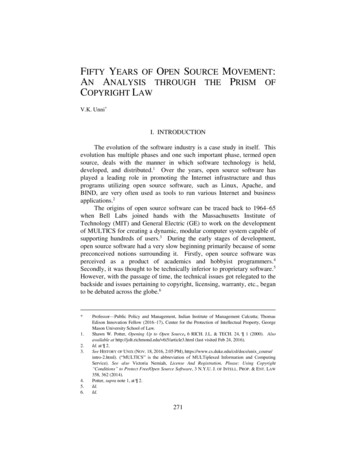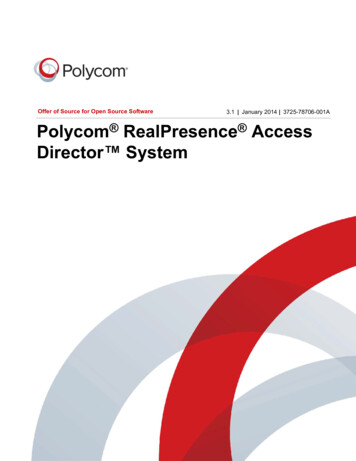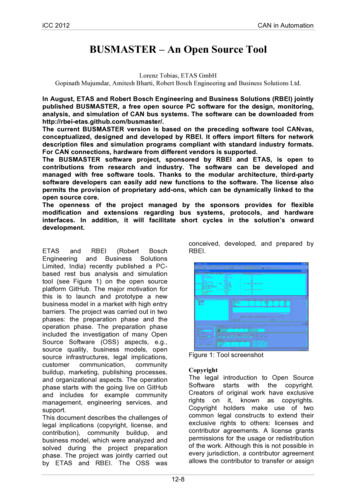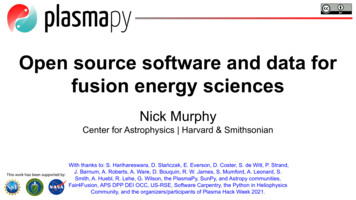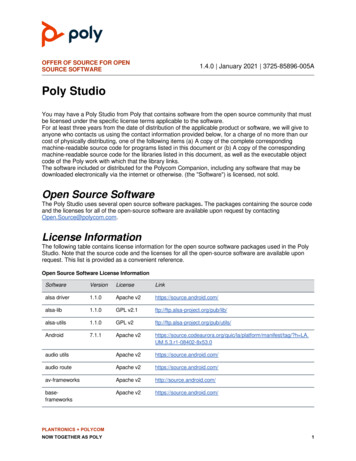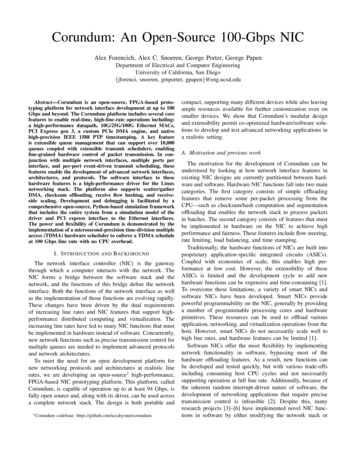
Transcription
Corundum: An Open-Source 100-Gbps NICAlex Forencich, Alex C. Snoeren, George Porter, George PapenDepartment of Electrical and Computer EngineeringUniversity of California, San Diego{jforenci, snoeren, gmporter, gpapen}@eng.ucsd.eduAbstract—Corundum is an open-source, FPGA-based prototyping platform for network interface development at up to 100Gbps and beyond. The Corundum platform includes several corefeatures to enable real-time, high-line-rate operations including:a high-performance datapath, 10G/25G/100G Ethernet MACs,PCI Express gen 3, a custom PCIe DMA engine, and nativehigh-precision IEEE 1588 PTP timestamping. A key featureis extensible queue management that can support over 10,000queues coupled with extensible transmit schedulers, enablingfine-grained hardware control of packet transmission. In conjunction with multiple network interfaces, multiple ports perinterface, and per-port event-driven transmit scheduling, thesefeatures enable the development of advanced network interfaces,architectures, and protocols. The software interface to thesehardware features is a high-performance driver for the Linuxnetworking stack. The platform also supports scatter/gatherDMA, checksum offloading, receive flow hashing, and receiveside scaling. Development and debugging is facilitated by acomprehensive open-source, Python-based simulation frameworkthat includes the entire system from a simulation model of thedriver and PCI express interface to the Ethernet interfaces.The power and flexibility of Corundum is demonstrated by theimplementation of a microsecond-precision time-division multipleaccess (TDMA) hardware scheduler to enforce a TDMA scheduleat 100 Gbps line rate with no CPU overhead.I. I NTRODUCTION AND BACKGROUNDThe network interface controller (NIC) is the gatewaythrough which a computer interacts with the network. TheNIC forms a bridge between the software stack and thenetwork, and the functions of this bridge define the networkinterface. Both the functions of the network interface as wellas the implementation of those functions are evolving rapidly.These changes have been driven by the dual requirementsof increasing line rates and NIC features that support highperformance distributed computing and virtualization. Theincreasing line rates have led to many NIC functions that mustbe implemented in hardware instead of software. Concurrently,new network functions such as precise transmission control formultiple queues are needed to implement advanced protocolsand network architectures.To meet the need for an open development platform fornew networking protocols and architectures at realistic linerates, we are developing an open-source1 high-performance,FPGA-based NIC prototyping platform. This platform, calledCorundum, is capable of operation up to at least 94 Gbps, isfully open source and, along with its driver, can be used acrossa complete network stack. The design is both portable and1 Corundumcodebase: https://github.com/ucsdsysnet/corundumcompact, supporting many different devices while also leavingample resources available for further customization even onsmaller devices. We show that Corundum’s modular designand extensibility permit co-optimized hardware/software solutions to develop and test advanced networking applications ina realistic setting.A. Motivation and previous workThe motivation for the development of Corundum can beunderstood by looking at how network interface features inexisting NIC designs are currently partitioned between hardware and software. Hardware NIC functions fall into two maincategories. The first category consists of simple offloadingfeatures that remove some per-packet processing from theCPU—such as checksum/hash computation and segmentationoffloading that enables the network stack to process packetsin batches. The second category consists of features that mustbe implemented in hardware on the NIC to achieve highperformance and fairness. These features include flow steering,rate limiting, load balancing, and time stamping.Traditionally, the hardware functions of NICs are built intoproprietary application-specific integrated circuits (ASICs).Coupled with economies of scale, this enables high performance at low cost. However, the extensibility of theseASICs is limited and the development cycle to add newhardware functions can be expensive and time-consuming [1].To overcome these limitations, a variety of smart NICs andsoftware NICs have been developed. Smart NICs providepowerful programmability on the NIC, generally by providinga number of programmable processing cores and hardwareprimitives. These resources can be used to offload variousapplication, networking, and virtualization operations from thehost. However, smart NICs do not necessarily scale well tohigh line rates, and hardware features can be limited [1].Software NICs offer the most flexibility by implementingnetwork functionality in software, bypassing most of thehardware offloading features. As a result, new functions canbe developed and tested quickly, but with various trade-offsincluding consuming host CPU cycles and not necessarilysupporting operation at full line rate. Additionally, because ofthe inherent random interrupt-driven nature of software, thedevelopment of networking applications that require precisetransmission control is infeasible [2]. Despite this, manyresearch projects [3]–[6] have implemented novel NIC functions in software by either modifying the network stack or
by using kernel-bypass frameworks such as the Data PlaneDevelopment Kit (DPDK) [7].FPGA-based NICs combine features of ASIC-based NICsand software NICs: they are capable of running at fullline rate and delivering low latency and precision timing,while having a relatively short development cycle for newfunctions. High-performance, proprietary, FPGA-based NICshave also been developed. For example, Alibaba developeda fully custom FPGA-based RDMA-only NIC that they usedto run a hardware implementation of a precision congestioncontrol protocol (HPCC) [8]. Commercial products also exist,including offerings from Exablaze [9] and Netcope [10].Unfortunately, similar to ASIC-based NICs, commerciallyavailable FPGA-based NICs tend to be proprietary with basic“black-box” functions that cannot be modified. The closednature of basic NIC functionality severely limits their utilityand flexibility for developing new networking applications.Commercially-available high-performance DMA components such as the Xilinx XDMA core and QDMA cores,and the Atomic Rules Arkville DPDK acceleration core [11]do not provide fully configurable hardware to control theflow of transmit data. The Xilinx XDMA core is designedfor compute offload applications and as such provides verylimited queuing functionality and no simple method to controltransmit scheduling. The Xilinx QDMA core and AtomicRules Arkville DPDK acceleration core are geared towardsnetworking applications by supporting a small number ofqueues and providing DPDK drivers. However, the numberof queues supported is small—2K queues for the XDMAcore and up to 128 queues for the Arkville core—and neithercore provides a simple method for precise control over packettransmission.Open-source projects such as NetFPGA [12] exist, but theNetFPGA project only provides a toolbox for general FPGAbased packet processing and is not specifically designed forNIC development. Moreover, the NetFPGA NIC referencedesign utilizes the propriety Xilinx XDMA core, which is notdesigned for networking applications. Replacing the XilinxXDMA core in the reference NIC design for the NetFPGAboard with Corundum results in a much more powerful andflexible prototyping platform.FPGA based packet-processing solutions include Catapult [13], which implements network application offloading,and FlowBlaze [14], which implements reconfigurable matchaction engines on FPGAs. However, these platforms leave thestandard NIC functions to a separate ASIC-based NIC andoperate entirely as a “bump-in-the-wire”, providing no explicitcontrol over the NIC scheduler or queues.Other projects use software implementations or partialhardware implementations. Shoal [15] describes a networkarchitecture that performs cell routing with custom NICsand fast Layer 1 electrical crosspoint switches. Shoal wasconstructed in hardware, but was only evaluated with synthetictraffic with no connection to a host. SENIC [3] describesscalable NIC-based rate-limiting. A hardware implementationof the scheduler was evaluated in isolation, but the system-level evaluation was carried out in software with a customqueuing discipline (qdisc) module. PIEO [16] describes aflexible NIC scheduler, which was evaluated in hardwarein isolation. NDP [5] is a pull-mode transmission protocolfor datacenter applications. NDP was evaluated with DPDKsoftware NICs and FPGA-based switches. Loom [6] describesan efficient NIC design, which is evaluated in software withBESS.The development of Corundum is distinguished from allof these projects because it is completely open source andcan operate with a standard host network stack at practicalline rates. It provides thousands of transmit queues coupledwith extensible transmit schedulers for fine-grained controlof flows. This leads to a powerful and flexible open-sourceplatform for the development of networking applications thatcombine both hardware and software functionalities.II. I MPLEMENTATIONCorundum has several unique architectural features. First,hardware queue states are stored efficiently in FPGAblock RAM, enabling support for thousands of individuallycontrollable queues. These queues are associated with interfaces, and each interface can have multiple ports, eachwith its own independent transmit scheduler. This enablesextremely fine-grained control over packet transmission. Thescheduler module is designed to be modified or swappedout completely to implement different transmit schedulingschemes, including experimental schedulers. Coupled withPTP time synchronization, this enables time-based scheduling,including high precision TDMA.The design of Corundum is modular and highlyparametrized. Many configuration and structural options canbe set at synthesis time by Verilog parameters, includinginterface and port counts, queue counts, memory sizes, scheduler type, etc. These design parameters are exposed in configuration registers that the driver reads to determine theNIC configuration, enabling the same driver to support manydifferent boards and configurations without modification2 .The current design supports PCIe DMA components for theXilinx Ultrascale PCIe hard IP core interface. Support for thePCIe TLP interface commonly used in other FPGAs is notimplemented, and is future work. This support should enableoperation on a much larger set of FPGAs.The footprint of Corundum is rather small, leaving amplespace available for additional logic, even on relatively smallFPGAs. For example, the Corundum design for the ExaNICX10 [9], a dual port 10G design with a PCIe gen 3 x8 interfaceand 512 bit internal datapath, consumes less than a quarter ofthe logic resources available on the second smallest KintexUltrascale FPGA (KU035). Table I, placed at the end of thepaper, lists the resources for several target platforms.The rest of this section describes the implementation ofCorundum on an FPGA. First, a high-level overview of themain functional blocks is presented. Then, details of several2 Corundumcodebase: https://github.com/ucsdsysnet/corundum
AppAXI liteStreamDMAPTPAXIL MDMA IFPTP HCTXQRXQPortPortRXCQTX schedulerDescfetchTXCQCplwriteEQScheduler ctrlTX engineDMACsumDMACsumHashMAC PHYSFP.OSPCIe HIPInterfaceInterface.DriverFPGARAMHostMAC PHYSFPRX engineFig. 1. Block diagram of the Corundum NIC. PCIe HIP: PCIe hard IP core; AXIL M: AXI lite master; DMA IF: DMA interface; PTP HC: PTP hardwareclock; TXQ: transmit queue manager; TXCQ: transmit completion queue manager; RXQ: receive queue manager; RXCQ: receive completion queue manager;EQ: event queue manager; MAC PHY: Ethernet media access controller (MAC) and physical interface layer (PHY).of the unique architectural features and functional blocks arediscussed.A. High-level overviewA block diagram of the Corundum NIC is shown inFig. 1. At a high level, the NIC consists of 3 main nestedmodules. The top-level module primarily contains supportand interfacing components. These components include thePCI express hard IP core and DMA interface, the PTPhardware clock, and Ethernet interface components includingMACs, PHYs, and associated serializers. The top-level modulealso includes one or more interface module instances.Each interface module corresponds to an operating-systemlevel network interface (e.g. eth0). Each interface modulecontains the queue management logic as well as descriptorand completion handling logic. The queue management logicmaintains the queue state for all of the NIC queues—transmit,transmit completion, receive, receive completion, and eventqueues. Each interface module also contains one or moreport module instances. Each port module provides an AXIstream interface to a MAC and contains a transmit scheduler,transmit and receive engines, transmit and receive datapaths,and a scratchpad RAM for temporarily storing incoming andoutgoing packets during DMA operations.For each port, the transmit scheduler in the port moduledecides which queues are designated for transmission. Thetransmit scheduler generates commands for the transmit engine, which coordinates operations on the transmit datapath.The scheduler module is a flexible functional block that can bemodified or replaced to support arbitrary schedules, which maybe event driven. The default implementation of the scheduleris simple round robin. All ports associated with the sameinterface module share the same set of transmit queues andappear as a single, unified interface to the operating system.This enables flows to be migrated between ports or load-balanced across multiple ports by changing only the transmitscheduler settings without affecting the rest of the networkstack. This dynamic, scheduler-defined mapping of queues toports is a unique feature of Corundum that can enable researchinto new protocols and network architectures, including parallel networks such as P-FatTree [17] and optically-switchednetworks such as RotorNet [18] and Opera [19].In the receive direction, incoming packets pass through aflow hash module to determine the target receive queue andgenerate commands for the receive engine, which coordinatesoperations on the receive datapath. Because all ports in thesame interface module share the same set of receive queues,incoming flows on different ports are merged together intothe same set of queues. It is also possible to add customizedmodules to the NIC to pre-process and filter incoming packetsbefore they traverse the PCIe bus.The components on the NIC are interconnected with severaldifferent interfaces including AXI lite, AXI stream, and acustom segmented memory interface for DMA operations,which will be discussed later. AXI lite is used for the controlpath from the driver to the NIC. It is used to initializeand configure the NIC components and to control the queuepointers during transmit and receive operations. AXI streaminterfaces are used for transferring packetized data within theNIC, including both PCIe transmission layer packets (TLPs)and Ethernet frames. The segmented memory interface servesto connect the PCIe DMA interface to the NIC datapath andto the descriptor and completion handling logic.The majority of the NIC logic runs in the PCIe user clockdomain, which is nominally 250 MHz for all of the currentdesign variants. Asynchronous FIFOs are used to interfacewith the MACs, which run in the serializer transmit and receiveclock domains as appropriate—156.25 MHz for 10G, 390.625MHz for 25G, and 322.266 MHz for 100G.The following sections describe several key functional
blocks within the NIC.B. Pipelined queue managementCommunication of packet data between the Corundum NICand the driver is mediated via descriptor and completionqueues. Descriptor queues form the host-to-NIC communications channel, carrying information about where individualpackets are stored in system memory. Completion queuesform the NIC-to-host communications channel, carrying information about completed operations and associated metadata.The descriptor and completion queues are implemented asring buffers that reside in DMA-accessible system memory,while the NIC hardware maintains the necessary queue stateinformation. This state information consists of a pointer to theDMA address of the ring buffer, the size of the ring buffer,the producer and consumer pointers, and a reference to theassociated completion queue. The required descriptor state foreach queue fits into 128 bits.The queue management logic for the Corundum NIC mustbe able to efficiently store and manage the state for thousandsof queues. This means that the queue state must be completelystored in block RAM (BRAM) or ultra RAM (URAM) on theFPGA. Since a 128 bit RAM is required and URAM blocksare 72x4096, storing the state for 4096 queues requires only 2URAM instances. Utilizing URAM instances enables scalingthe queue management logic to handle at least 32,768 queuesper interface.In order to support high throughput, the NIC must beable to process multiple descriptors in parallel. Therefore,the queue management logic must track multiple in-progressoperations, reporting updated queue pointers to the driver asthe operations are completed. The state required to track inprocess operations is much smaller than the descriptor state,and as such it can be stored in flip-flops and distributed RAM.The NIC design uses two queue manager modules:queue manager is used to manage host-to-NIC descriptorqueues, while cpl queue manager is used to manageNIC-to-host completion queues. The modules are similar except for a few minor differences in terms of pointer handling,fill handling, and doorbell/event generation. Because of thesimilarities, this section will discuss only the operation of thequeue manager module.The BRAM or URAM array used to store the queue stateinformation requires several cycles of latency for each readoperation, so the queue manager is built with a pipelinedarchitecture to facilitate multiple concurrent operations. Thepipeline supports four different operations: register read, register write, dequeue/enqueue request, and dequeue/enqueuecommit. Register-access operations over an AXI lite interfaceenable the driver to initialize the queue state and providepointers to the allocated host memory as well as access theproducer and consumer pointers during normal operation.C. Transmit schedulerThe default transmit scheduler used in the CorundumNIC is a simple round-robin scheduler implemented in theHostDataNICHostDriverIFPortDriverIFPort(a) Traditional NIC, port assignment madein softwareDataNICDriverIFPortPort(b) Corundum NIC, port assignment madein hardwareFig. 2. NIC port and interface architecture comparisontx scheduler rr module. The scheduler sends commands to the transmit engine to initiate transmit operationsout of the NIC transmit queues. The round-robin schedulercontains basic queue state for all queues, a FIFO to storecurrently-active queues and enforce the round-robin schedule,and an operation table to track in-process transmit operations.Similar to the queue management logic, the round-robintransmit scheduler also stores queue state information inBRAM or URAM on the FPGA so that it can scale to supporta large number of queues. The transmit scheduler also uses aprocessing pipeline to hide the memory access latency.The transmit scheduler module has four main interfaces:an AXI lite register interface and three streaming interfaces.The AXI lite interface permits the driver to change schedulerparameters and enable/disable queues. The first streaminginterface provides doorbell events from the queue managementlogic when the driver enqueues packets for transmission. Thesecond streaming interface carries transmit commands generated by the scheduler to the transmit engine. Each commandconsists of a queue index to transmit from, along with atag for tracking in-process operations. The final streaminginterface returns transmit operation status information back tothe scheduler. The status information informs the scheduler ofthe length of the transmitted packet, or if the transmit operationfailed due to an empty or disabled queue.The transmit scheduler module can be extended or replacedto implement arbitrary scheduling algorithms. This enablesCorundum to be used as a platform to evaluate experimentalscheduling algorithms, including those proposed in SENIC [3],Carousel [4], PIEO [16], and Loom [6]. It is also possible toprovide additional inputs to the transmit scheduler module,including feedback from the receive path, which can be usedto implement new protocols and congestion control techniquessuch as NDP [5] and HPCC [8]. Connecting the scheduler tothe PTP hardware clock can be used to support TDMA, whichcan be used to implement RotorNet [18], Opera [19], and othercircuit-switched architectures.D. Ports and interfacesA unique architectural feature of Corundum is the splitbetween the port and the network interface so that multipleports can be associated with the same interface. Most currentNICs support a single port per interface, as shown in Fig. 2a.When the network stack enqueues a packet for transmission ona network interface, the packets are injected into the networkvia the network port associated with that interface. However,in Corundum, multiple ports can be associated with eachinterface, so the decision over which port a packet will injected
into the network can be made by hardware at the time ofdequeue, as shown in Fig. 2b.All ports associated with the same network interface moduleshare the same set of transmit queues and appear as a single,unified interface to the operating system. This enables flowsto be migrated between ports or load-balanced across multiple ports by changing only the transmit scheduler settingswithout affecting the rest of the network stack. The dynamic,scheduler-defined mapping of queues to ports enables researchinto new protocols and network architectures, including parallel networks such as P-FatTree [17] and optically-switchednetworks such as RotorNet [18] and Opera [19].E. Datapath, and transmit and receive enginesPCIe HIPDMA IFStreamDMAInterfaceInterface PortPortDescfetchCplwriteTX engineDMACsumDMACsumRX engineHashMAC PHYSFP.DriverRAMFPGAHost.Corundum uses both memory-mapped and streaming interfaces in the datapath. AXI stream is used to transfer Ethernetpacket data between the port DMA modules, Ethernet MACs,and the checksum and hash computation modules. AXI streamis also used to connect the PCIe hard IP core to the PCIeAXI lite master and PCIe DMA interface modules. A custom,segmented memory interface is used to connect the PCIeDMA interface module, port DMA modules, and descriptorand completion handling logic to internal scratchpad RAM.The width of the AXI stream interfaces is determined bythe required bandwidth. The core datapath logic, except theEthernet MACs, runs entirely in the 250 MHz PCIe user clockdomain. Therefore, the AXI stream interfaces to the PCIe hardIP core must match the hard core interface width—256 bitsfor PCIe gen 3 x8 and 512 bits for PCIe gen 3 x16. On theEthernet side, the interface width matches the MAC interfacewidth, unless the 250 MHz clock is too slow to providesufficient bandwidth. For 10G Ethernet, the MAC interfaceis 64 bits at 156.25 MHz, which can be connected to the 250MHz clock domain at the same width. For 25G Ethernet, theMAC interface is 64 bits at 390.625 MHz, necessitating aconversion to 128 bits to provide sufficient bandwidth at 250MHz. For 100G Ethernet, Corundum uses the Xilinx 100Ghard CMAC cores on the Ultrascale Plus FPGAs. The MACinterface is 512 bits at 322.266 MHz, which is connected tothe 250 MHz clock domain at 512 bits because it needs to runat approximately 195 MHz to provide 100 Gbps.MAC PHYSFPFig. 3. Simplified version of Fig. 1 showing the NIC datapath.A block diagram of the NIC datapath is shown in Fig. 3,which is a simplified version of Fig. 1. The PCIe hard IP core(PCIe HIP) connects the NIC to the host. Two AXI streaminterfaces connect the PCIe DMA interface module to the PCIehard IP cores. One interface for read and write requests, andone interface for read data. The PCIe DMA interface moduleis then connected to the descriptor fetch module, completionwrite module, port scratchpad RAM modules, and the RXand TX engines via a set of DMA interface multiplexers.In the direction towards the DMA interface, the multiplexerscombine DMA transfer commands from multiple sources. Inthe opposite direction, they route transfer status responses.They also manage the segmented memory interfaces forboth reads and writes. The top-level multiplexer combinesdescriptor traffic with packet data traffic, giving the descriptortraffic higher priority. Next, a pair of multiplexers combinetraffic from multiple interface modules. Finally, an additionalmultiplexer inside each interface module combines packet datatraffic from multiple port instances.The transmit and receive engines are responsible for coordinating the operations necessary for transmitting and receivingpackets. The transmit and receive engines can handle multiplein-progress packets for high throughput. As shown in Fig. 1,the transmit and receive engines are connected to severalmodules in the transmit and receive data path, including theport DMA modules and hash and checksum offload modules,as well as the descriptor and completion handling logic andthe timestamping interfaces of the Ethernet MACs.The transmit engine is responsible for coordinating packettransmit operations. The transmit engine handles transmitrequests for specific queues from the transmit scheduler. Afterlow-level processing using the PCIe DMA engine, the packetwill then pass through the transmit checksum module, MAC,and PHY. Once the packet is sent, the transmit engine willreceive the PTP timestamp from the MAC, build a completionrecord, and pass it to the completion write module.Similar to the transmit engine, the receive engine is responsible for coordinating packet receive operations. Incomingpackets pass through the PHY and MAC. After low-levelprocessing that includes hashing and timestamping, the receiveengine will issue one or more write requests to the PCIe DMAengine to write the packet data out into host memory. Whenthe writes complete, the receive engine will build a completionrecord and pass it to the completion write module.The descriptor read and completion write modules aresimilar in operation to the transmit and receive engines.These modules handle descriptor/completion read/write requests from the transmit and receive engines, issue enqueue/dequeue requests to the queue managers to obtain the queueelement addresses in host memory, and then issue requests tothe PCIe DMA interface to transfer the data. The completionwrite module is also responsible for handling events from thetransmit and receive completion queues by enqueuing them inthe proper event queue and writing out the event record.F. Segmented memory interfaceFor high performance DMA over PCIe, Corundum uses acustom segmented memory interface. The interface is splitinto segments of maximum 128 bits, and the overall widthis double that of the AXI stream interface from the PCIehard IP core. For example, a design that uses PCIe gen
3 x16 with a 512-bit AXI stream interface from the PCIehard core would use a 1024-bit segmented interface, splitinto 8 segments of 128 bits each. This interface providesan improved “impedance match” over using a single AXIinterface, enabling higher PCIe link utilization by eliminatingbackpressure due alignment in the DMA engine and arbitrationin the interconnect logic. Specifically, the interface guaranteesthat the DMA interface can perform a full-width, unalignedread or write on every clock cycle. Additionally, the use ofsimple dual port RAMs, dedicated to traffic moving in a singledirection, eliminates contention between the read and writepaths.Each segment operates similar to AXI lite, except withthree interfaces instead of five. One channel provides the writeaddress and data, one channel provides the read address, andone channel provides the read data. Unlike AXI, bursts andreordering are not supported, simplifying the interface logic.Interconnect components (multiplexers) are responsible forpreserving the ordering of operations, even when accessingmultiple RAMs. The segments operate completely independently of each other with separate flow control connections andseparate instances of interconnect ordering logic. In addition,operations are routed based on a separate select signal and notby address decoding. This feature eliminates the need to assignaddresses and enables the use of parametrizable interconnectcomponents that appropriately route operations with minimalconfiguration.Byte addresses are mapped onto segmented interface addresses with the lowest-order address bits determining the bytelane in a segment, the next bits selecting the segment, andthe highest-order bits determining the word address for thatsegment. For example, in a 1024-bit segmented interface, splitinto 8 segments of 128 bits, the lowest 4 address bits woulddetermine the byte lane in a segment, the next 3 bits woulddetermine the segment. The remainder of the bits determinethe address bus for that segment.G. Device DriverThe Corundum NIC is connected to the Linux kernel networking stack with a kernel module. The module is responsiblefor initializing the NIC, registering kernel interfaces, allocatingDMA-accessible buffers for descriptor and completion queues,handling device interrupts, and passing network traffic betweenthe kernel and t
interface. Both the functions of the network interface as well as the implementation of those functions are evolving rapidly. These changes have been driven by the dual requirements of increasing line rates and NIC features that support high-performance distributed computing and virtualization. The increasing line rates have led to many NIC .
